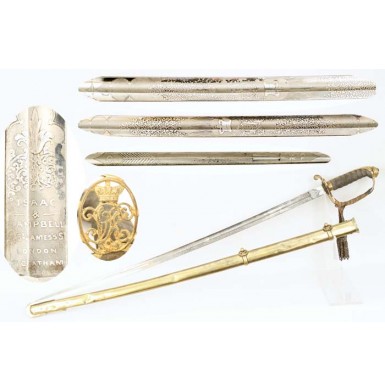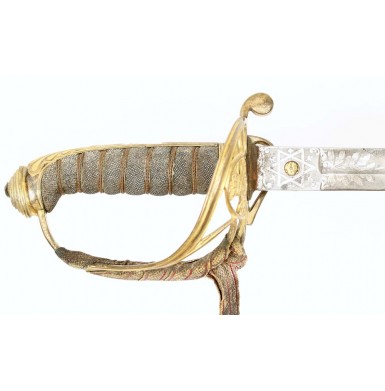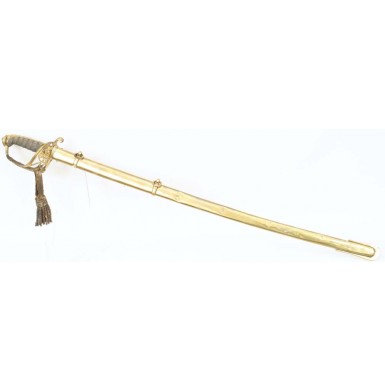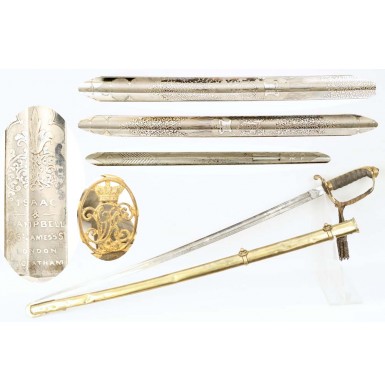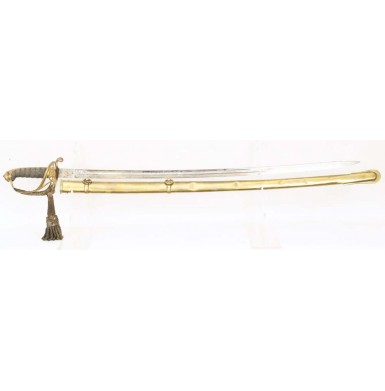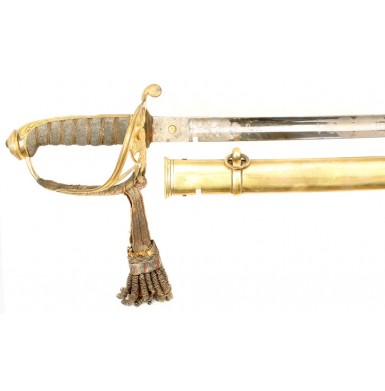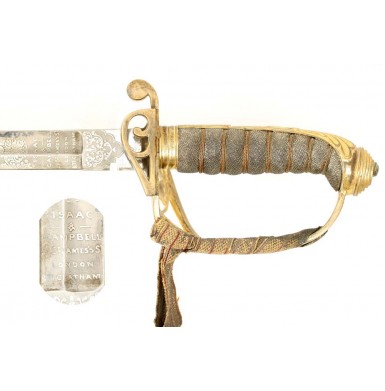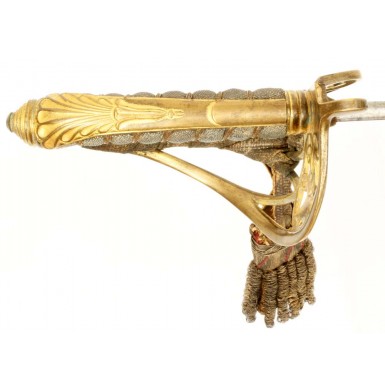Gorgeous Isaac, Campbell & Company Marked P-1845 Officer's Sword
- Product Code: EWSK-1511-SOLD
- Availability: Out Of Stock
-
$1.00
This is a VERY FINE example of the British Pattern 1845 Infantry Officer’s Sword retailer marked by the largest and most famous supplier of English arms and equipment to the southern Confederacy, S. Isaac, Campbell & Company. The sword is brass hilted with a folding guard on the reverse, and would sometimes be referred to by the British as a Pattern1822/45 Officer’s Sword. The “/45” in the designation indicates that the sword was manufactured with the post-1845 pattern blade, but the balance of the sword really conformed to 1822 Pattern. Due to problems with the breakage of blades, a more robust blade design was officially adopted in 1845. The blade design was pioneered by Wilkinson during the early 1840’s and was significantly stronger than the original P-1822 pipe-back design. In 1827 an iron hilted variant was also adopted, primarily for use with Rifle Regiments, and both the P-1822 and P-1827 were in use simultaneously through the mid-19th century. By the mid-1840’s the folding guard was no longer a common feature (again due to breakage) and stronger guards became standard. However the folding guard was not officially removed from the British regulations until 1854. Even then, it was not uncommon for the earlier pattern hilt to be found on British Volunteer officer’s swords into the early 1860s. The brass guards of these swords usually featured the royal cypher of Queen Victoria, a Crown over an intertwined “VR” in the guard. Sometimes this symbol was replaced with customized Confederate symbols on southern purchased swords. Many of these swords were provided through military goods dealers like S. Isaac, Campbell & Co to officer’s of both the standing British Army and the British Volunteer regiments. Like many retailers, S. Isaac, Campbell & Co often relied on Solingen based cutlers to provide the majority of their edged weapons, and did not produce swords in house. In general these swords were nominally 38 ““ in overall length, with 32 ““ spear point blades with a single fuller. Minor variations in dimensions have been noted on those swords that were sold commercially, and not to the British military, and at least one known example with Confederate heritage has a rather short 30 ““ blade. The sword was typically paired with a brass mounted leather scabbard, although both sheet iron and sheet brass scabbards have been encountered. These English pattern swords, were popular with Confederate officers. A number of P-1827/45 and P-1845 swords have been noted in period photographs, indicating that they were purchased in some quantity. However, it is not clear how many of them may have actually featured Confederate blade etchings and embellishments. The identified image of Captain William H Murray of Co A, 1st Maryland Battalion of Infantry clearly shows the hilt of an English P-1827/45 sword. Captain Murray is also wearing an English sword belt with “snake buckle” in the image. Lt. Lawrence Anderson of Co. A 1st Florida Infantry also sat for his image with an English P-1827/45 sword and can be seen wearing an English “snake buckle” belt as well. His sword is a standard British pattern sword, without any Confederate embellishments, and it resides in the collection of the Museum of Florida History in Tallahassee. Lt. Anderson was killed on April 6, 1862 at Shiloh. These are but two easily documented examples of known Confederate officer’s posing with the P-1827/45 sword. A P-1845 pattern sword is also known marked by Firmin & Sons with the early pattern hinged brass guard and traditional Crown/VR cypher in the hilt, but with Confederate pattern naval motif etchings on the blade. A Halfmann & Taylor (Montgomery, AL) retailer marked P-1845 is also known, again with the folding guard with but a Confederate eagle motif in place of Victoria’s cypher and again Confederate motifs on the blade. Both swords feature the Solingen style brass “proved” disc in the ricasso that is so often encountered on these sword of English origin. For every clearly “Confederate” embellished example, it is quite likely that many more purely English decorated swords were purchased from British sources. Additional proof of the purchase of these sword patterns by the Confederacy comes from an invoice in the McRae papers, which clearly refers to the purchase of “officer’s swords”. The invoice is from S. Isaac, Campbell & Company, and it lists “59 Officers Swords “ 19/6” and “1 Case “ 10/6”. The officer’s sword were billed at 19 schillings, 6 pence and according to the invoice, the case was to be marked OS /59 in a rhomboid. This indicated “Officer’s Swords “ 59 total”. Unfortunately the invoice is not dated, but due to the number of swords of this pattern found in early war images, I believe the invoice was from the late fall of 1861 or the very beginning of 1862. While there are certainly examples of British pattern Confederate purchased swords with Confederate motifs etched on the blades and included in the guards, it is probable that the majority of the early officer’s sword purchases retained the standard British motifs on the blades, as the swords were purchased from the stock on hand at S. Isaac, Campbell & Company.
The British Pattern 1845 Infantry Officer’s Sword offered her is retailer marked by S. Isaac, Campbell & Company and remains in VERY FINE condition. The reverse ricasso is etched in six lines:
ISAAC
&
CAMPBELL
St JAMES’s St
LONDON
CHATHAM
The firm of S. Isaac, Campbell & Company was probably the most famous and most important supplier of arms, equipment and material to the southern Confederacy during the American Civil War. The firm was established in 1845 as Samuel Isaac, “Military Contractor & Tailor” in Chatham, Kent at 71 High Street. In 1848 the company expanded by opening an office in London at 21 St. James Street and by using the new moniker Isaac Samuel, Army Contractor. As the firm grew, selling more and more “military supplies’ (much like an old time chandler), Isaac changed the name to Samuel Isaac & Company in 1851 and then to S. Isaac, Campbell & Company in 1852. During this time the firm maintained their 71 High Street address in Chatham, but in mid-1861, sometime after the outbreak of the American Civil War, they moved their primary London location to 71 Jermyn Street, an address that is well known to collectors as it appears on many of the items sold to the Confederacy by the company. S. Isaac Campbell & Company had initially built their business on lucrative British military contracts. These included a major uniform contract to supply “clothing to the whole of the British Army in the East”, as well as a May 1858 contract to supply “regulation boots” (shoes) to the British Army. Unfortunately, a scandal alleging bribery and malfeasance resulted in the firm being banned from doing business with the British military in June of 1858. Ordinarily this would have ruined a military outfitter, who relied upon military contracts to remain in business, but luckily for the company the British “Volunteer” movement was afoot, a government sanctioned creation of local militia groups that could be called upon to augment the standing arm in times of war. For many of these groups, however, membership in such a “Volunteer Regiment” was much more akin to joining a shooting club or in some cases an elite social club, with some regiments formed by wealthy ne’er-do-wells who thought they looked dashing in a military uniform. While certainly not as substantial or reliable as government contracts, the items supplied to volunteers did not have meet the standards of the British Government, nor pass their rigorous inspection process. This allowed the company to make very good profits on mediocre quality goods. Delving into the field of potentially “shoddy” quality uniforms and accouterments provided S. Isaac, Campbell & Company the experience that they needed when the biggest cash cow to hit Great Britain during the 19th century arrived; the American Civil War. On May 10, 1861 Major Caleb Huse, chief purchasing officer for the Confederate military in England arrived in Liverpool, from whence he traveled to London and took residence at 58 Jermyn Street, across from the newly opened offices of S. Isaac, Campbell & Company at 71 Jermyn Street. About one month later, SIC & Co accepted their first order from the Confederacy, for 2,000 sets of accouterments, and a major economic relationship would be established that would remain in effect for the majority of the war. The basis of the deal arranged was that SIC & Co would acquire the necessary goods for Huse and charge a flat percentage over the actual cost of the items SIC & Co purchased, along with the cost of necessary expenses like insurance, shipping, etc. Over the coming years, SIC & Co would supply the Confederacy with nearly every conceivable item needed for an army in the field, its administration and its support. Items ranged from uniforms, blankets, cloth and buttons to accouterments, medical and scientific instruments and of course, guns and swords. Not only did the firm supply the Confederate central government, but also Confederate state governments and Confederate speculators who purchased items on “speculation” hoping to sell them for large profits in the war torn and blockaded south. Speculative purchases ranged from military items and weapons to various luxury items difficult to get in the south during the war, including things like ladies dresses, china, flatware and even perfume. As of February of 1863 Huse had purchased over one million pounds worth of supplies from S. Isaac, Campbell & Company, including “417,262 worth of small arms, “110,525 worth of clothing, and “54,973 worth of accouterments, just to list some of the purchases. SIC & Co, in their typically “less than forthright” manner treated their Confederate customers with disdain and often inflated the “cost” of the items provided between 5% and 20%, and then charged their premium on top of that. The excessive costs resulted in an investigation of both SIC & Co and Huse, which cleared the latter of any wrong doing, but also discovered the second set of books being kept by SIC & Co that revealed their duplicity. Although the Confederacy essentially ended their relationship with firm “officially” by mid-1863, the ever wily Isaacs managed to sell additional items south during 1864 through what amounted to front men, offering items made in the Isaac’s own factories. The end of the Civil War and the loss of the war by the Confederacy sounded the death knell for the firm. With many outstanding invoices yet to be paid by the south, and even more paid via the Erlanger loan and southern cotton bonds that were now worthless, the firm was forced to declare bankruptcy in 1869. In the end, it was S. Isaac, Campbell & Company’s largest customer, the Confederate States of America that ruined the firm financially. Thanks to my friend Dave Burt “across the pond” for his wonderful monograph Major Caleb Huse C.S.A. and S. Isaac Campbell & Co for the detailed background on the firm.
The Isaac, Campbell & Company marking on this sword, with the St. James Street, London address places the saber somewhere between 1854 (the earliest date it could have possibly been produced based upon pattern) and early 1861, as SIC & Co were in their new location by May of 1861. Of course the firm did not discard old inventory that bore the old address, nor did they discard letterhead upon the move, as extant Confederate invoices from SIC & Co bearing the St. James Street address are dated as late as October of 1861. Realistically the sword itself was probably acquired by S. Isaac, Campbell & Company sometime between mid and late 1850, and it is quite impossible at this time to know to whom it was sold. It is also very possible that the sword sat around the SIC & Co establishment, collecting dust and not selling until the Confederacy was desperate for arms of all types, especially officer’s swords. It is interesting to note that several English made swords with Confederate provenance are known with the S. Isaac, Campbell & Company and the St. James street address, suggesting that they were clearly “emptying the warehouse” of stale inventory when the Confederacy came to call. This may also explain the St. James street marked, Isaac & Campbell retailed Webley Long Spur revolver that I recently offered.
In addition the Isaac & Campbell mark on the reverse ricasso, the obverse ricasso is etched with a 6-pointed star surrounding a brass disc within the ricasso, which is marked PROVED. Like so many of the swords and saber bayonets imported by the Confederacy through S. Isaac, Campbell & Company, this sword is of Solingen origin. The sword is in VERY FINE condition, and retains most of the brilliant polish and etched frosting on the blade. The 32 ““ blade is mostly brilliant, with only some small areas of fading and dulling, and some tiny scattered flecks of minor surface oxidation and minimal pinpricking. The blade has a 21 ““ fuller and shows etches motifs on both sides for about 19 ““ of its length. The etching retains about 85%+ of its original frosting and remains vibrant, crisp and extremely clear. Both sides of the blade retain beautifully executed floral splays against frosted panel backgrounds, with finely etched Crown/VR royal cyphers that have rays of sun emanating form the crowns. The spine of the blade is etched with a 3 ““ long C (ARROW) * P frosted panel, about 11” from the tip of the blade. The blade is free of any pitting, but does show a couple of tiny areas of very lightly flecked discoloration. The balance of the brilliant blade shows no sharpening, and appears to retain the original factory edge. The edge of the blade is also free of any significant nicks or dings, and the tip remains quite sharp. The 5 ““ long hilt has an attractive brass guard that retains about 50% of its original gold gilt finish. An original British officer’s gold bullion sword knot is attached to the lower guard branch. The knot is in about VERY GOOD+ to NEAR FINE condition and shows an uncleaned patina with some minor wear and loosening of the gold wire in the fringe. The sword knot more that likely covers and protects even more original gold gilt finish. The beautifully executed Crown over intertwined “VR” retains a large amount of the gold finish, with the grip showing the expected wear and finish loss from handling and carriage. The folding guard on the offside of the hilt is in excellent condition and functions smoothly, locking securely into both the extended and folded positions. The back of the brass grip shows a neatly executed shell motif splay and the pommel cap shows the typical concentric rings of this pattern of sword. The peen where the blade tang is secured at the pommel cap remains completely untouched and original. The blade to hilt junction remains extremely tight with no noticeable wiggle or wobble. The original leather throat washer is in place on the blade where meets the hilt as well. The shangreen covered grip remains in VERY FINE condition as well, and shows only the expected light wear from carry and use. The majority of this minor wear is along the high edges where the sword would be gripped. The grip retains about 95%+ of this original wrap. The 7 grooves of the hilt are further embellished with three-strand wire wrap, which features 2 plain wire strands on either side of a wound wire. All of the wire is present and in tact, with all of the wire remaining quite tight. The sword is contained within its original, simple sheet brass scabbard. The scabbard has the same general patina as the brass hilt. The sword fits the scabbard perfectly. The scabbard retains both of the original brass suspension rings. The metal of the scabbard is in nice, untouched condition. The scabbard shows numerous small to medium sized dents and dings on both sides, indicating that the sword was really carried and used. The lyre shaped brass drag also shows wear and long along the lower edge, further indication that the saber was carried quite a bit by an officer who was walking long distances.
Overall this is a really lovely example of a very fine and scarce British officer’s sword, retailer marked by the most important English supplier to the Confederacy. While it is unclear if this sword was actually sold to southern buyers, or whether it was purchased by a British officer, the following are clear: 1) the sword is retailer marked by S. Isaac, Campbell & Company, 2) swords of this pattern are known with Confederate provenance and are seen in images of Confederate officers, 3) at least some English officer’s swords with standard British military motifs on their blades were purchased by the Confederacy, 4) no one can prove conclusively that the sword was not an early Confederate purchase. All this combines into one really gorgeous Isaac & Campbell marked sword that is in fantastic condition and displays like a $10,000 sword, for about 15% of the price! If you have ever wanted a great looking Confederate officer’s sword that would impress your friends without spending huge amounts of money, this is the perfect one. It is a perfect representative example with a wonderful Isaac & Campbell retailer mark, but priced at not much more than a typical British sword. This is lot of sword for the money and a real bargain in terms of condition and eye appeal!
SOLDTags: Gorgeous, Isaac, Campbell, Company, Marked, P, 1845, Officers, Sword

